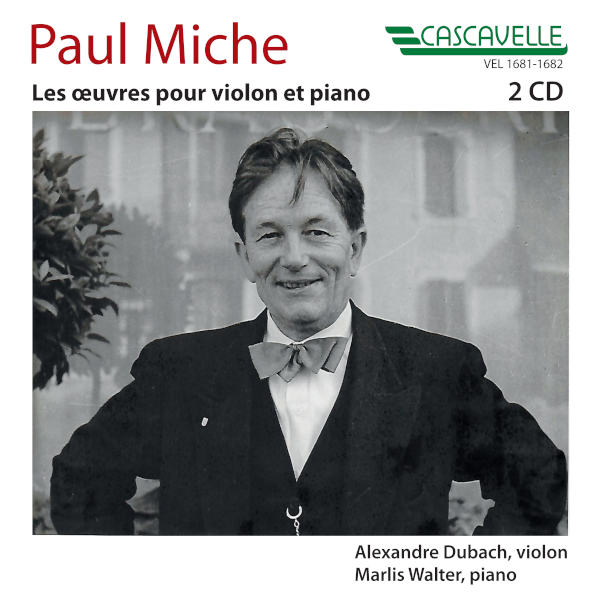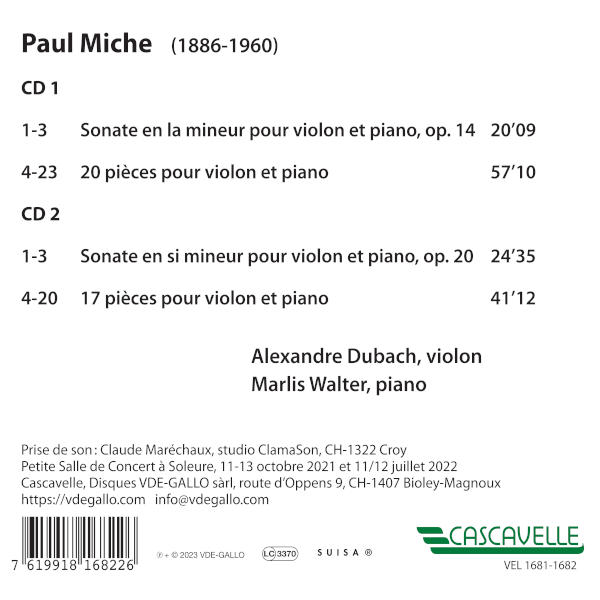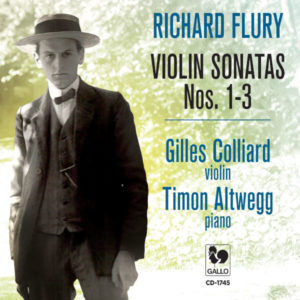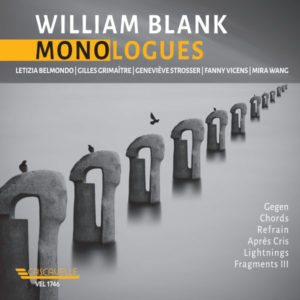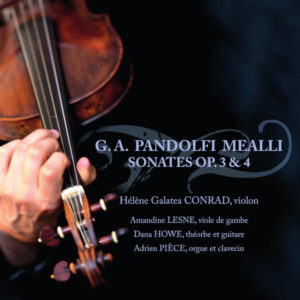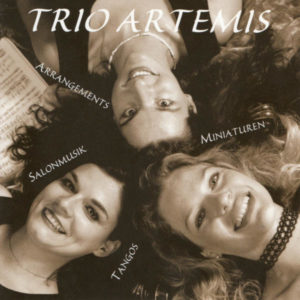Extraits / Excerpts
CD 1:
CD 2:
Paul Miche: Works for Violin and Piano - Alexandre Dubach, Violin - Marlis Walter, Piano
CD1:
Paul MICHE: Violin Sonata in A Minor, Op. 14: I. Grave – Allegro risoluto – II. Andante pastorale – III. Allegro comodo – Valse-Bluette, Op. 7, No. 1 – Désir, Op. 7, No. 2 – En cueillant des fleurs, Op. 7, No. 3 – Quand vient le printemps – Quand vient l’été – Quand vient l’automne, Op. 8, No. 1 – Quand vient l’hiver – Veille de Noël, Op. 8, No. 2 – Chanson d’amour, Op. 8, No. 3 – Humoresque, Op. 9, No. 1 – Aveu, Op. 9, No. 2 – Feuillet d’album, Op. 9, No. 3 – Sous bois, Op. 10, No. 1 – Recueillement, Op. 10, No. 2 – Aubade printaniere, Op. 10, No. 3 – Musette, Op. 12, No. 1 – Le chant de ma mère, Op. 12, No. 2 – Noël passé, Op. 12, No. 3 – Echo de mon village, Op. 21, No. 1 – Romance, Op. 17.
CD2:
Paul MICHE: Violin Sonata in B Minor, Op. 20: I. Allegro con fantasia – II. In Memoriam (Andante espressivo) – III. Allegro con ritmo – Perpetuum mobile – Rêverie – Souvenir de Colombier – Pastorale – Mélodie sans paroles – Intermezzo – Souvenir d’une Marguerite – Simple chanson – Contemplation – Méditation – Miniature – Jour d’automne – Sourire – Tristesse – Un rêve – Heure mystique – Berceuse d’avril.
Alexandre Dubach, Violin – Marlis Walter, Piano.
Paul Miche
The composer and violinist Paul Miche was born on 20 April 1886 in Courtelary in the Bernese Jura. He received his first violin lessons from Georges Pantillon in La-Chaux-de-Fonds, who also taught him harmony. In 1906 Miche became a pupil of Henri Marteau at the Geneva Conservatory, graduating with distinction in violin performance just one year later. He then followed his teacher to the Royal Academy of Music in Berlin, where he also became a composition student of Max Bruch and pursued further violin studies with the famous pedagogue Carl Flesch. Miche was a member of the Stuttgart String Quartet from 1910 until 1911, when he was appointed professor of violin at the Geneva Conservatory. He held this position for 40 years until his retirement. At the beginning of the 1930s, however, he took a leave of absence for three years and visited Egypt. He was probably encouraged to do so by his friend Jacques-René Fiechter, the then director of the Swiss School in Alexandria, of whom Miche set many texts to music.
Especially in his younger years, Miche often appeared as a soloist in orchestral concerts or at chamber music evenings with the pianists Adolphe Veuve and Emil Frey. For a short time, he was also a member of the Orchestre de la Suisse Romande.
Miche’s earliest compositions date from when he was 18. Already after completing his studies in 1909, he had 12 pieces for violin and 4 for piano published by Ries and Erler in Berlin. Soon he also wrote songs for soprano and piano as well as other works for violin and piano. Miche performed his two violin sonatas at the Festivals of the Swiss Musicians’ Association in St. Gallen in 1913 and in Schaffhausen in 1924, with Jo- seph Lauber at the piano. A “Romance” was commissioned by the Geneva Conservatory in 1926 as a sightreading piece for its diploma examinations in violin. Thereafter, from the age of 40 onwards, Paul Miche devoted himself mainly to composing a cappella works for mixed choir, women’s choir and men’s choir. These are strophic songs with fresh, interesting harmonies, entirely in the tradition of Emile Jaques-Dalcroze and Gustave Doret. Around 200 of his choruses were published, mostly by Foetisch Frères, and were very popular with the choral societies of French-speaking Switzerland until the middle of the last century. His best-known piece for choir, “Terre jurassienne”, is today regarded almost asthe anthem of the canton of Jura, whose founding Miche, a separatist sympathiser, unfortunately did not live to see. The composer died quite unexpectedly in Geneva on 7 September 1960 after a routine operation, though he had looked much younger than his 74 years, and was still active.
Urs Joseph Flury
- Categories
- Composers
- Interprets
- Booklet
